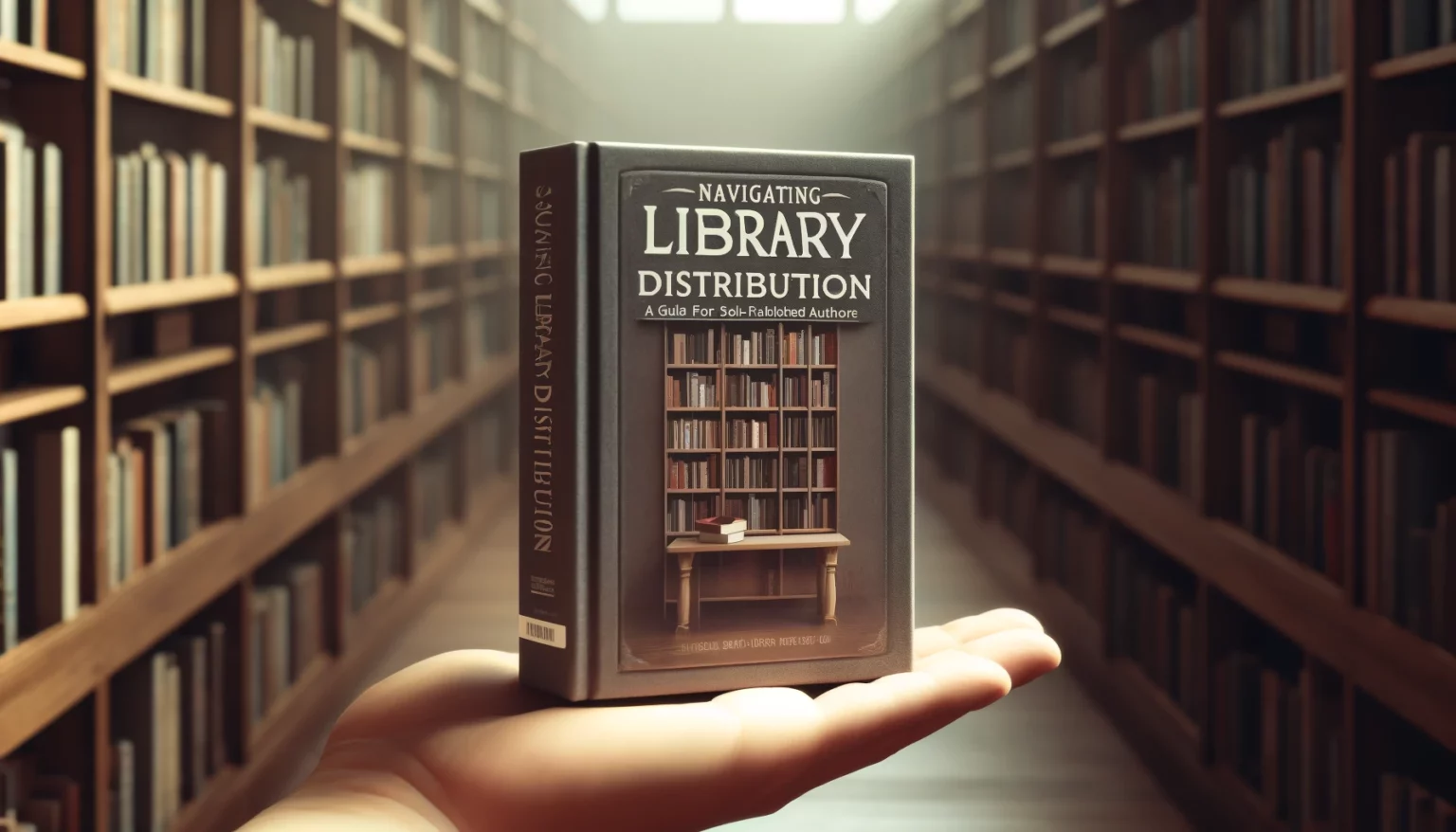Navigating the complex world of library distribution presents a unique and rewarding opportunity for self-published authors. Libraries serve as vital access points to a diverse and engaged audience, spanning from avid readers and book clubs to academic researchers and students. For self-published authors, getting their work into libraries means not just increased visibility but also an endorsement from trusted community institutions, which can significantly amplify their book’s reach and credibility.
This guide aims to demystify the process of library distribution, offering a roadmap for self-published authors to get their books onto library shelves and into the hands of eager readers. We will explore the nuances of library users’ needs, the distinct characteristics of academic versus public libraries, and the intricacies of the library market. Furthermore, we’ll delve into practical strategies for engaging with library distribution channels, understanding purchasing processes, and leveraging digital platforms to maximize the potential of book distribution for self-publishers.
By the end of this guide, self-published authors will be equipped with the knowledge and tools necessary for navigating library distribution confidently, ensuring their stories find a home within the invaluable resource that is the library.
Understanding Library Users
Library users constitute a broad and varied demographic, each with unique needs and preferences that shape the fabric of library collections. Community members, encompassing individuals and families from various backgrounds, frequent libraries in search of leisure reading, educational materials, and resources that support lifelong learning. They value a wide range of genres and formats, from the latest bestsellers and classic literature to self-help guides and children’s books. Libraries serve as a nexus for community engagement, offering spaces for book clubs, storytelling sessions, and cultural events that cater to the interests of local patrons.
Students and educators, on the other hand, rely on libraries for academic resources and research materials. They seek access to scholarly articles, textbooks, reference materials, and specialized databases that support curriculum needs and academic pursuits. Libraries, particularly those in academic institutions, are integral in providing the tools necessary for education, study, and scholarly inquiry.
The evolving demands of these diverse user groups directly influence library collection development. Libraries are increasingly embracing digital formats, with e-books and audiobooks becoming indispensable alongside traditional print collections. This shift not only reflects changing reader preferences but also addresses the need for accessibility, convenience, and a broader reach. Digital lending platforms and online catalogs allow users to access a wealth of resources from anywhere, further democratizing information and fostering a culture of reading and learning.
Librarians play a crucial role in curating collections that resonate with their community’s needs, often relying on user feedback, circulation data, and emerging trends to make informed decisions. Navigating library distribution is a dynamic interaction between library users and collection development ensures that libraries remain responsive, relevant, and invaluable resources in their communities, continually adapting to serve the diverse needs of their patrons.
Your Publishing Journey Awaits – Start NowThe Landscape of Academic and Public Libraries
The landscape of libraries is diverse, with academic and public libraries serving distinct yet complementary roles within their communities. Academic libraries are typically situated within educational institutions such as colleges and universities, and their collections are curated with a focus on supporting the curriculum, research, and educational goals of their institutions. These libraries house an extensive range of scholarly materials, including academic journals, specialized research databases, and comprehensive collections in specific disciplines. Their user base mainly consists of students, faculty, and researchers who rely on these resources for academic work, making these libraries critical for advancing knowledge and scholarship.
In contrast, public libraries are community-centered institutions designed to meet the broader needs of the public they serve. Their collections are more diverse, encompassing fiction and non-fiction books across various genres, children’s literature, multimedia resources, and often local history archives. Public libraries aim to cater to all age groups and interests, making their spaces welcoming for leisure reading, self-education, and community engagement. They host a range of programs, from literacy classes and educational workshops to cultural events, serving as vibrant community hubs that foster a love for reading, lifelong learning, and social interaction.
The distinction between academic and public libraries also extends to their roles in the community. Academic libraries are essential for supporting the academic mission and providing resources that underpin teaching, learning, and research activities. They often offer specialized services such as research consultations, information literacy training, and access to academic technologies. Public libraries, on the other hand, position themselves as inclusive spaces that promote accessibility to information, digital literacy, and community well-being. By offering free access to a wide array of materials and services, public libraries play a pivotal role in leveling the educational and informational playing field, ensuring that everyone in the community has the opportunity to learn, grow, and be entertained.
Key Aspects of Navigating Library Distribution
Navigating library distribution is a critical step for authors who want to self-publish a book aiming to widen their readership. Unlike traditional publishing paths, where established relationships facilitate entry into library collections, self-published authors must often chart their course to gain visibility in this space. Understanding the various distribution channels available is the first step in this journey.
Distribution Channels
Library distribution channels for self-published authors can broadly be categorized into direct and indirect pathways. Direct distribution involves approaching libraries individually, a method that can be particularly effective with local public libraries interested in supporting local authors. This approach, however, can be time-consuming and may not scale well for broader distribution.
Indirect distribution, on the other hand, leverages the services of distributors and aggregators who specialize in supplying content to libraries. These entities act as intermediaries between authors and libraries, managing the complexities of cataloging, metadata provision, and digital rights management. Distributors like Ingram and Baker & Taylor, for example, have extensive networks that reach a vast number of libraries, both academic and public. Aggregators, such as OverDrive and Bibliotheca, focus more on digital content, providing e-books and audiobooks to library catalogs accessible by patrons through specialized apps.
The role of these distributors and aggregators is pivotal. They not only streamline the process of getting books into library systems but also ensure that books meet the specific requirements and standards libraries uphold, such as proper cataloging and metadata for easy discovery. They can also manage the digital rights and lending models that libraries use, which is particularly important for e-books and audiobooks.
Role of Distributors and Aggregators
For self-published authors, working with library distributors begins with understanding the terms and conditions of each distributor or aggregator, including the revenue models, rights management, and distribution reach. Authors should ensure their books are properly formatted, have professional-quality covers, and include all the necessary metadata to increase their appeal to libraries and their patrons. Additionally, obtaining ISBNs for their titles can enhance credibility and facilitate smoother integration into library catalogs.
Building relationships with library distributors also involves engaging in marketing and promotional activities to raise awareness of one’s work among librarians and library users. This can include participating in library-focused trade shows, offering promotional copies, and engaging in direct outreach to librarians to highlight the value and relevance of the author’s work to their collections.
In sum, leveraging library distribution channels effectively requires self-published authors to navigate the intricacies of distribution networks, understand the roles of various players in the library ecosystem, and actively promote their titles to ensure their books find a place on library shelves, both physical and digital.
Understanding the Library Market
Understanding the library market involves grasping the intricacies of the purchasing and collection development processes that libraries undertake. Libraries typically allocate budgets for acquisitions based on factors such as community needs, collection gaps, and emerging trends. Librarians play a crucial role in assessing these factors and curating collections that cater to the diverse interests and requirements of their patrons.
Budgeting
Budget concerns often loom large in library purchasing decisions, particularly in the face of limited funding and competing priorities. Librarians must carefully balance their budgets to ensure they can acquire a diverse range of materials while also meeting operational expenses. As such, they prioritize titles that offer high value and relevance to their community, often favoring works with demonstrated demand or critical acclaim.
Format Preferences
Perpetual access models and the availability of various formats are significant considerations for libraries when making acquisitions. Perpetual access models, which grant libraries permanent ownership of digital content, offer assurance that materials will remain accessible to patrons indefinitely. This contrasts with subscription-based models, where access is contingent on ongoing payments and can be revoked if subscriptions lapse. Libraries value perpetual access models for their long-term sustainability and commitment to providing enduring access to information.
Similarly, the availability of materials in various formats is essential for meeting the diverse preferences and needs of library users. While print books remain a staple of library collections, the demand for digital formats such as e-books and audiobooks continues to rise. Libraries recognize the importance of offering materials in formats that accommodate different reading preferences and accessibility needs. Consequently, they actively seek out titles available in multiple formats to ensure broad accessibility and inclusivity.
By understanding the purchasing dynamics, budget constraints, and format preferences within the library market, self-published authors can tailor their distribution strategies to align with libraries’ acquisition priorities. Emphasizing the value, relevance, and accessibility of their works can increase the likelihood of their books being selected for inclusion in library collections, ultimately expanding their reach and impact among library users.
Strategies for Entering the Library Market
Entering the library market as a self-published author requires strategic planning and careful consideration of how to make your books appealing to libraries. Here are some key strategies to help you succeed:
Optimize Book Appeal
Firstly, focus on making your books attractive to libraries by paying attention to essential factors such as metadata, cover design, and professional reviews. Metadata is crucial for ensuring that your books are discoverable in library catalogs, so ensure that your titles are accurately categorized and tagged with relevant keywords. Invest in professional cover design to make your books visually appealing and stand out on library shelves or in online catalogs. Additionally, seek out professional reviews from reputable sources to lend credibility to your work and demonstrate its quality to librarians.
Network with Librarians and Staff
Networking and relationship-building with librarians and library staff can also significantly enhance your chances of success in the library market. Attend library conferences, book fairs, and other industry events to connect with librarians and learn more about their needs and preferences. Take the time to introduce yourself and your books, and be prepared to provide them with promotional materials or copies for review. Building personal relationships with librarians can increase their willingness to consider your books for inclusion in their collections and recommend them to their patrons.
Promotions and Discounts
Furthermore, consider offering special promotions or discounts specifically for libraries to incentivize them to purchase your books. This could include offering bulk discounts on multiple copies or providing exclusive content or supplementary materials for library editions of your books. By demonstrating your commitment to supporting libraries and providing value to their patrons, you can strengthen your appeal as a self-published author within the library market.
In conclusion, entering the library market as a self-published author requires a combination of strategic planning, attention to detail, and relationship-building. By focusing on making your books appealing to libraries through metadata optimization, professional cover design, and positive reviews, as well as actively networking with librarians and offering value-added incentives, you can increase your chances of success and expand your readership within the library community.
Leveraging Technology and Digital Platforms
Leveraging technology and digital platforms is essential for self-published authors aiming to tap into the growing market of e-books and digital lending in libraries. With the increasing popularity of digital reading, libraries have expanded their collections to include a wide range of e-books and audiobooks, offering patrons convenient access to content from their computers, tablets, and smartphones.
Self-published authors can distribute their e-books and audiobooks to libraries through various channels, including library distributors, aggregators, and direct submissions to library catalogs. Working with distributors and aggregators specializing in digital content, such as OverDrive and Bibliotheca, enables authors to reach a broad network of libraries and their patrons. These platforms handle the technical aspects of distribution, including formatting, metadata, and digital rights management, streamlining the process for authors.
Additionally, authors can utilize library service platforms and digital resources to enhance their visibility and engagement with libraries. Platforms like LibraryThing and Goodreads offer opportunities for authors to connect with librarians, promote their books, and participate in virtual events and discussions. By actively engaging with library communities online and providing valuable content, self-published authors can build relationships with librarians and increase the discoverability of their works within library catalogs.
In conclusion, this guide has illuminated the pathways for authors who want to use self-publishing services to navigate the intricate world of library distribution. By understanding the needs of library users, the dynamics of academic and public libraries, and key strategies for entering the library market, authors can effectively position their works for inclusion in library collections. I encourage self-published authors to explore library distribution as a valuable component of their publishing strategy, leveraging the opportunities it presents to reach new readers, enhance their visibility, and contribute to the vibrant ecosystem of libraries as vital community resources.







